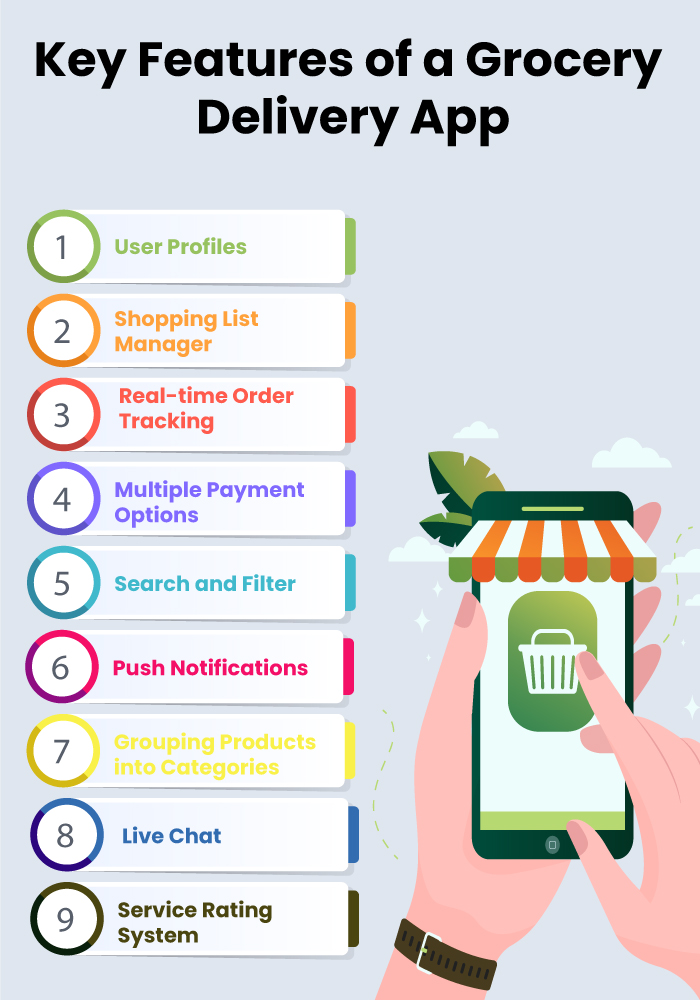October 11, 2022
By: PhoenixBizz Staff Writer
PhoenixBizz is a division of Sofvue, LLC
Printed with permission of Data Titan and Sofvue LLC
Grocery mobile apps are becoming increasingly popular and important. More and more consumers are using their smartphones to do their shopping, from creating shopping lists to comparing prices, and for good reason. People are quickly realizing that gas prices are not coming down anytime soon, so saving pennies is more important now than ever, and using a mobile app to place your order, and then have your groceries ready-for-pickup or delivered to your front door saves you time… and more importantly, money.
Grocery store owners are taking full advantage of this opportunity by creating mobile apps that make shopping easier for customers on the go, and it’s growth track is impressive, with predicted growth to exceed $243B by 2025.
To get started, you’ll first need a plan. That said, here's everything you need to know.
What Is a Grocery Mobile App?
A grocery mobile app is a mobile application that allows users to order groceries (everything from Apricots to Zebra Cakes). Groceries can be delivered straight to your home, or you can schedule a drive-by pickup during normal hours.
A grocery mobile app also allows customers to pay for their order (using a credit card, mobile wallet like Apple Pay, or cash on delivery or pickup), track deliveries, and receive notifications about special offers. At the same time, the app should offer a user-friendly interface that makes shopping easy and seamless.
Why Your Grocery Needs a Delivery Mobile App?
Whether your business is retail or wholesale, grocery delivery services are a great way to expand your revenue and customer base. It's also a great way to expand brand identity.
The grocery industry is massive, and many people are looking for fresh produce and other items on the go. By providing an easy way to access products and services, you can increase interest in your brand and create more sales opportunities through a mobile app delivery system.
Here are some statistics that drive the point home.
➤ The number of grocery app users in the US has increased from 27.9 million in 2021 to 30.4 million in 2022. [statista]
➤ The average annual spend per online grocery buyer will increase from $856.47 in 2021 to $1,524.84 in 2025. [Insiderintelligence]
➤ Coresight’s US online grocery survey in 2022 found that 54.3% of US consumers have purchased groceries online in the past 12 months. [retailwire]
➤ Customers purchasing the bulk of their groceries online grew to 28.3% in 2022, as opposed to 24.7% in 2021 and 14% in 2020. [retailwire]
➤ In August 2022, over 68 million households bought at least one grocery item online via delivery, pickup, or ship-to-home. [brickmeetsclick]
Key Features of a Grocery Delivery App
While the features of your online grocery app depend on what you want to offer to your customers, here are some must-have functionalities.

#1. User Profiles
A user profile is a feature that allows users to store their personal information. This includes addresses, payment methods, email addresses, and other data. It should include a record of your customer's buying history and preferences so customers can store and reuse personalized shopping lists from prior visits.
#2. Shopping List Manager
A grocery shopping list is a must-have for any user of a grocery mobile app. It allows users to create and manage their shopping lists, add items using voice-activated commands or text-to-speech technology, and share the list with family members.
Your app might also let customers create multiple lists so they can create repeat orders quickly. For instance, they can create one grocery shopping list for their favorite recipes and another with their “weekly for Home” list.
#3. Real-time Order Tracking
This feature allows users to track their orders in real-time. They can see the progress of their order, view previous orders, and cancel orders, typically up to four hours prior to a scheduled delivery or pickup. Real-time order tracking also helps keep customers informed on how far along their delivery is, which is especially important when ordering food or refrigerated items.
#4. Multiple Payment Options
Different payment options should be available in the app (such as debit/credit cards, mobile wallets, net banking, etc.), allowing users to pay via their preferred methods.
Simultaneously, you should offer a pay-on-delivery option to ensure customers do not abandon their cart due to payment issues. You may also allow users to pay for multiple orders in advance, especially with recurring orders, making it more convenient to purchase from your grocery.
#5. Search and Filter
The mobile app should allow users to search for products so they can quickly find and order items they need instead of scanning through thousands of products. Also, you should auto-populate the search bar (predictive search) as the user types out the information they are searching for (example mentioned below).
Filter controls allow users to find items with specific characteristics, such as gluten-free, zero trans-fat, etc. This makes it easier for people with allergies or those on a diet to order groceries from you.
#6. Push Notifications
Push notifications are a great way to keep users aware of what's going on in your grocery app. For example, you might send push notifications about order status, new products and deals, rewards, gift cards, driver location, and more.
Also, push notifications can be a great way to keep customers engaged with your brand. Push notifications allow you to send targeted messages directly to their phones, giving customers reminders about orders they have placed or providing suggestions for similar products based on their previous purchase history.
For example, if someone buys milk regularly but hasn’t ordered it lately, you might send a push notification reminding them that milk is on sale until the end of the day. This can help increase sales without spending extra money on marketing or advertising!
#7. Grouping Products into Categories
Grouping products into categories helps users find products faster. The categories can be based on product type, brand, price, or other attributes. For example, coffee could be grouped into subcategories like instant coffee and ground coffee.
Categories can also be hierarchical with sub-categories such as "instant coffee" under "coffee." These are helpful for users as they provide visual cues that increase user engagement and recall when searching for a particular brand or category of item in the store.
#8. Live Chat
Live chat customer service is a great way to answer customers’ questions 24/7. Whether a user is looking for more information about an item, wondering about delivery times or trying to track an order, the live chat feature allows customers to talk to someone on your customer support team who can provide answers to real-time questions.
#9. Service Rating System
A service rating system is a tool for customers to rate their experience with a business. This information is valuable for both customers and businesses. The rating system allows customers to see ratings before ordering, so they can make the best decisions about where they'll spend their money.
Further, businesses can analyze reviews to understand what's working well in their stores and what needs improvement. This allows you, as the grocery store owner, to work on improving your store’s experience, which in turn produces better future experiences for your customers.
Read this blog: Knowing The Key Steps In Developing An On-Demand Delivery App
Cost of Grocery Delivery App Development
The cost of developing a grocery delivery app depends on many factors, including size, features, and functionality. However, average costs range from $30K - $450K, depending on the number of developers working on the project.
Also, here are a few more issues that might affect your grocery delivery app development costs.
✅ The complexity of your feature set: If you want a simple application with just a few screens and features, it will be much less expensive than an enterprise-level system with many screens, complex data flows between them, and API integrations with other systems.
✅ User base: Your users should also play an essential role when calculating the costs associated with your grocery delivery app development because it will directly impact the development hours needed to complete such projects.
✅ The number of platforms: Another critical factor affecting the grocery delivery app development cost is how many platforms you want your application to support. There are three platforms available today. They include iOS, Android, and Windows, but at present, Windows only has about 1% of the marketplace.
How Can Phoenix Bizz Help You?
Phoenix Bizz is a leading mobile application and custom software development company. We build a wide array of mobile app solutions, including grocery delivery apps. We have completed over 200 projects, and we are known for our superior product quality and post-development support.
We closely work with our clients to understand their exact business goals, and we undertake a six-step development methodology that works beyond compare. The PhoenixBizz team has been developing custom web-based applications, Apple and Android mobile apps, custom databases, MVP’s, prototypes, and custom databases since 2004. This equates to over $22MM in custom-designed and developed solutions for companies across the United States. To learn more, call our Phoenix office at 623-845-2747.
Review this portfolio: Granville Foods
Support Links:
Insider Intelligence: https://www.insiderintelligence.com/insights/digital-grocery-industry/
Statista: https://www.statista.com/statistics/1013928/number-of-grocery-app-users-us/
RE: 11118









